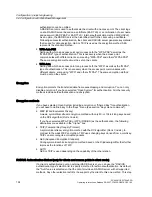
Configuration / project engineering
5.6 Configuration with Web Based Management
SCALANCE W786-xPRO
120
Operating Instructions, Release 08/2007, C79000-G8976-C221-02
technology divides a data packet into several smaller packets that are transmitted at the
same time at different frequencies.
Special options for 802.11g settings
The options you can set in the Advanced G submenu relate to the way in which
management and control data (RTS/CTS frames, beacons) are sent in the 802.11g mode.
You can also specify that the SCALANCE W-700 only supports 802.11g-compatible devices.
Handling 802.11b clients
The access point automatically detects whether 802.11b clients exist in the area. To avoid
802.11g packets colliding with 802.11b packets, the access point can use the RTS/CTS
method.
Using RTS/CTS (in access point mode only)
With the "802.11g CTS Mode" drop-down list box, you specify the use of RTS/CTS:
None
Do not use RTS/CTS.
Always
Always use RTS/CTS with 802.11g packets.
Auto
Only use RTS/CTS when there are 802.11b clients in area.
You can set the data rate for RTS/CTS frames in the "802.11g CTS Rate" drop-down list
box.
With the "802.11g CTS Type" drop-down list box, you specify whether only a CTS or
RTS/CTS is sent.
802.11g enhancements
With the "802.11g Short Slot Time" parameter, you specify whether or not the short slot time
is used. This short slot time should be supported by all newer clients.
With the "802.11g Only Mode" parameter, you can specify that only 802.11g clients can log
on at the access point and also that only 802.11g rates are permitted (in access point mode
only). In this mode, only the OFDM modulation method is used. This prevents 802.11b
devices from registering. If 802.11g Only mode is disabled, both 802.11b devices and
802.11.g devices can register with the access point.
5.6.4.7
Data Rates menu command
Note
The "Data Rates" submenu is available only in access point mode.
















































